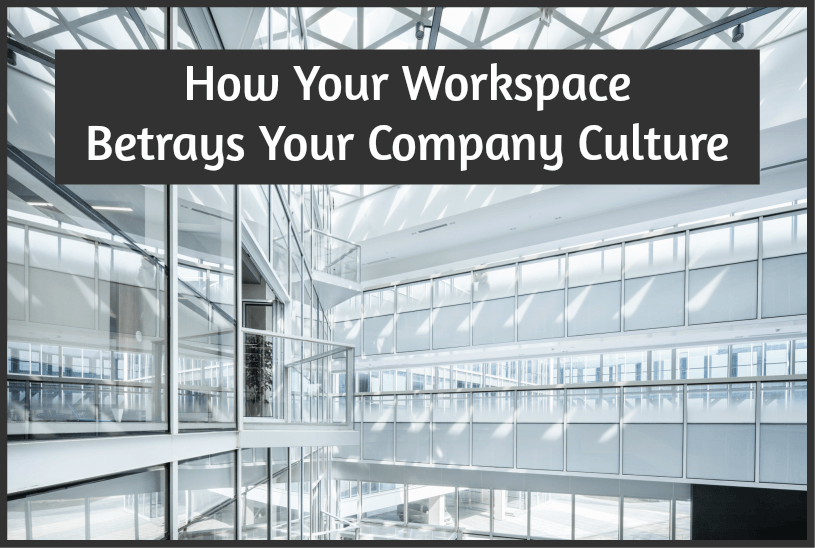
How Your Workspace Betrays Your Company Culture
Offices are often seen as functional spaces, designed to help facilitate workflow. But all offices are the product of the human imagination which is itself a function of our unconscious biases, personality traits, and underlying assumptions.
To think that your office space says nothing about your company culture is naive.
In fact, it could be one of the best ways to determine what your company is all about.
As human beings, we’re constantly adjusting and adapting to our environment. When you walk into a workspace, you’re immediately influenced by your surroundings, whether you want to be or not. The decor, layout and even temperature can all make a difference to how you feel: anxious, tense, nervous, relaxed, happy, or euphoric.
Businesses have been trying to perfect their workspaces since the 1960s when top business people began to realize that they could adjust worker satisfaction and productivity by providing certain kinds of environments.
One of the early pioneers in this arena was Robert Propst. Propst began designing offices for insurance companies and banks that provided an ergonomic and flexible space for workers, with the intention of boosting output per employee in companies that wanted to shed staff.
The early goals of office design weren’t particularly humanistic, but they were undoubtedly a move in that direction. However, Probst’s initial intention was undermined in the 1970s and 1980s, when office workers were moved into atomized “cubicles,” forced to work in visual isolation from their colleagues for no apparent reason.
The cubicle was perhaps the ultimate example of deranged office space thinking, and symbolic of a monolithic corporate culture which saw people as cogs in a wheel, rather than something biological and essential.
Today, offices have moved on considerably. Few businesses still implement the old cubicle model. But office spaces still speak volumes about the company culture, and not all of it is good. Let’s take a look.
It Can Show You Don’t Value Groups
Companies could get away with atomizing workers in the past because a lot of what people did relied on individual effort, not collaboration. For instance, bank clerks could process accounts by themselves without consulting other team members. As a result, it made sense to either sit them in rows in large rooms or to have them cut off from other team members by artificial cubicle barriers.
But that old model no longer applies to 21st-century businesses. It’s rare today that a company can operate without significant interaction between various teams. Product designers have to work with marketing (as well as other members of their team), and with financial officers and so on. Creating great outcomes is no longer a “one man task.”
Your office space betrays how you value groups. If you have private office space dedicated to team interactions, then there’s a good chance that you seen the group or team as the primary unit of labor. If, however, you have a series of sectioned desks or glass-fronted executive suites, then you probably value individual achievement above all else.
It’s worth looking at what some of the world’s top entrepreneurs do to facilitate team interactions. Elon Musk, for instance, works in the corner of a large open office at SpaceX, alongside everyone else from the CFO all the way down to the intern engineers. Musk does this because he understands the value of open communication and collaboration. People need to be able to talk to each other to get things done. And offices which physically discourage conversation do so emotionally too.
It Can Show You Don’t Trust Your Employees
People like their privacy, even in professional office environments. But many companies try to remove as much privacy as possible, tracking everything their employees do in both software and in reality.
One of the most visible signs you don’t trust your employees is the glass-fronted executive supervisor office. The original purpose of these offices was so that managers could observe workers on the factory floor and intervene if they saw that they weren’t following company best practice. But then glass-fronted offices then moved into the services office environment. Financials, retailers and a bunch of other companies began seeing them as a way of establishing hierarchy and giving high-ranking managers supervisory powers.
The problem with this approach is what it says to your employees.
It says that you don’t trust them ahead of time before they’ve done anything to warrant that lack of trust. It creates resentment and a sense that they’re being treated like criminals, even if they have no intention of behaving as such.
Supervisory offices also destroy people’s desire for initiative. People who believe that they’re under the boot of management don’t internalize the needs of the company. Because of this, they don’t push on with new projects which could generate new products of ideas for the firm. In other words, they may foster stagnation – the last thing you want in a fast-changing economy.
It Can Show Your Lack Of Creativity
Although not all businesses need to be creative, most do. Creativity is fast becoming the currency of the modern world, as more and more rote tasks are done by machines (even complex ones like marketing and accounting). But if your office isn’t set up for creativity, you can run into trouble.
Some of today’s most innovative firms design their office space in a way that facilitates creativity. No, we’re not just talking about putting pictures on the wall – we’re talking about making things like office furniture and tables moveable so that you can adapt to new needs and circumstances.
Granted, being able to move the furniture might not make a huge difference, but it can help to give unconscious permission for people to be creative. Employees who are allowed to modify their workspace may also feel inclined to change the way they think about a particular issue faced by your business.
It Can Show You Avoid Conflict
Conflict in the workplace is a necessary part of running an effective business. Avoiding conflict is not an option: it’s how you manage it that counts.
Successful businesses incorporate the need to resolve conflict into their office design by creating small spaces or perhaps three or four seats where people can go to thrash out issues. These spaces can then be used for conversation and allow conflicts to be contained away from the main workspace.
It Can Show That You Don’t Value Introspection
Although most firms do not facilitate team interactions enough, a few take it too far in the opposite direction. Research shows, for instance, that open offices don’t work in the long-term because people (especially introverts) need time out from others in their environment. In short, workers need space to be able to reflect and concentrate on individual tasks, even if that’s just the process of learning new material.
The best offices take this need into account. Private space isn’t just the privilege of management, but something all employees can access, should they need it. People need a space to reflex, unwind, and socially recharge before going into a meeting or making a case to their team. Others may want a private area where they can get some peace and concentrate on a project.
It Can Show You That You Don’t Value Innovation
Innovation is the lifeblood of modern business. It’s what allows firms to continue over a long period in a continually changing marketplace. But if your office isn’t set up for innovation, your company could fail.
What does a pro-innovation office look like?
First of all, innovative office spaces promote the needs of the team above that of the individual. The best offices recognize that the team is the unit of production and that relevant knowledge exists on the team level.
This conclusion isn’t just some marketing claim, but an actual reflection of the reality in most companies.
Many firms do not realize that the quality of their products emerges from the interactions of team members. Companies become overly obsessed with hierarchy and do not fully recognize the latent talent available at the team level.
Offices can play a vital role in breaking down barriers between workers in different places in the corporate hierarchy. The best work-spaces create areas which teams can use flexibly to come up solutions to their problems.
Google, for instance, provides a range of themed zones in its offices to allow people to collaborate in different ways. Some of these areas are formal, like boardrooms, while others are more laid back and resemble games rooms.
Not all companies have the resources that Google does, but that doesn’t mean that you can’t find office space that will meet many of your team’s needs.
If like most employers, you’re concerned about your teams working together, then finding an office which facilitates this should be a priority. Ideally, you want to avoid just buying “space” and instead look for offices with specific team-building spaces.
So, now that you’ve learned this, what do you think of your office?
Does it betray your corporate culture?
And, if so, does it do so in a good way or not?
© New To HR


